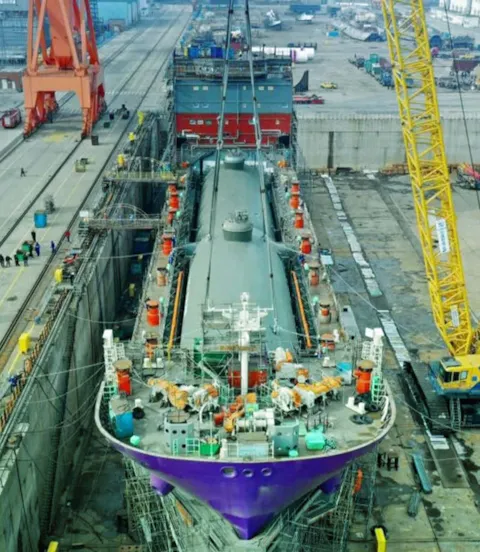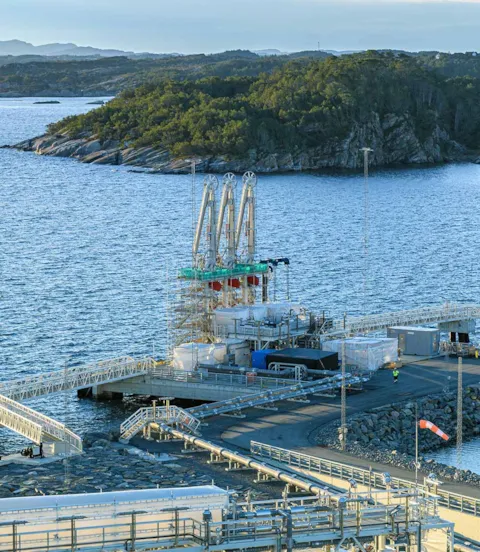Positive outlook for carbon shipping amid big push to solve technical challenges
Carbon Capture and Storage (CCS), a promising decarbonization method, requires a value chain for CO2 transport and storage to serve estimated future demands. DNV’s Mathias Sørhaug surveys the status, challenges and opportunities of CO2 shipping within the CCS value chain featuring key insights from energy company Equinor and Athens-based shipowner and mid-stream service company ECOLOG.
The International Energy Agency (IEA) estimates in its Net-Zero Roadmap that to achieve the 1.5°C global warming limit set by the Paris Agreement, we need to capture 7.6 billion tons of CO2 annually by 2050. In its July 2023 update, the Global CCS Institute (GCCSI) reports that current CCS projects in operation can capture and store about 50 megatons of CO2 annually. This implies that from 2023 to 2050, CCS capacity must increase at least 100 times to capture the projected 7.6 billion tons of CO2.
CCS emerges as a crucial technology in Europe’s green shift
In Europe, CCS is listed as one of the key green shift technologies in the Net-Zero Industry Act of March 2023 and many projects have received innovation funding. The GCCSI highlights a 48% increase in CO2 capture projects just in the 12 months from 2022 to 2023, which is a very positive indicator for the future. However, very few final investment decisions are so far in place. A lot depends on the EU ETS carbon price trajectory and the potential to receive financial support from the likes of the EU Innovation Fund.
“CCS isn’t a competitive solution at current carbon pricing. But the price is expected to rise as the sum of allowances shrinks. Essentially, for CCS to be a commercially attractive option for decarbonization the cost of capturing, transporting and storing CO2 must be lower than the carbon price,” Mathias Sørhaug, Business Development Director CO2 Shipping at DNV Maritime states.
Northern Lights: Cross-border CO2 storage project set to launch in 2025
One of the only firm projects now going ahead is Phase 1 of Northern Lights in Norway, uniting TotalEnergies, Shell and Equinor to develop cross-border CO2 transport and storage for emitters across Europe. On track for start-up in 2025, it is part of the Norwegian government-funded Longship full-scale CCS pilot scheme that includes a cement factory in Brevik. Northern Lights also has CO2 offtake deals with Yara in the Netherlands and Ørsted in Denmark for a total of around 1.6 million tons per annum (mtpa) for Phase 1.
Equinor also has a 100% license from the Norwegian government for the Smeaheia CO2 storage site on the Norwegian Continental Shelf. The project aims to inject 5 mtpa of CO2 from European customers there by 2028. Overall, the company ambition is to develop value chains for CO2 transport and storage with an annual capacity of 30–50 million tons of CO2 (Equinor share) by 2035. “The project is exploring two transport concepts – a pipeline solution and a ship-transport solution together with a land-based import terminal,” Knut Maråk, Principal Researcher at Equinor shares.
Europe takes lead in advancing CO2 market development
“Europe is leading efforts to get the full chain going and it feels like the market is developing fast,” Jasper Heikens, CCO at ECOLOG, a mid-stream CO2 service company says. Not all projects will materialize, but he expects many will go to final investment decisions and start construction closer to 2030.
ECOLOG, a sister company of Peter Livanos-controlled GasLog and DryLog, aims to build a business that can liquefy, transport and store CO2 anywhere in the world using a dedicated fleet of Liquid CO2 (LCO2) carriers and terminals. “Initially we’re looking at terminals of 5 mtpa then, when possible, scaling to 10 mtpa. Technology in the value chain is fairly well understood, so there aren’t too many technical hurdles to actually achieving the necessary scale. A lot will depend on regulatory decisions and government funding,” Heikens explains.

Rising demand in global CO2 transportation expected
“The US is making great strides in developing extensive land-based storage capacity. However, there is still much work to be done to further develop the entire chain linking carbon emitters to storage providers,” Heikens states. The Inflation Reduction Act (IRA), introduced by President Biden in 2022, has served to incentivize CCS activities by increasing the value of the 45Q tax credit, which effectively raises the price of CO2 to a more profitable level. The credit is given for each metric ton of CO2 captured and securely stored.
Looking at CCS activities in Asia, Heikens notes that carbon capture is also being explored extensively there. One of the drivers to undertake CCS is that industries in Asia will need to adhere to the EU’s forthcoming Carbon Border Adjustment Mechanism (CBAM) if they wish to sell their products into the EU. This requires a price to be paid for embedded carbon in products sold into the EU. If Asian manufacturers do not reduce their carbon emissions, their products could potentially become less competitive when sold in the EU.
“Asia will emerge as the biggest CO2 shipping market with the biggest ships because Japan and Korea have very limited storage capacity and will need to transport their CO2 over greater distances than the EU to, for example, Malaysia, Indonesia or Australia. Potential storage projects in those countries and in the US will help the proliferation of CO2 shipping. In future, we’ll also see big CO2 vessels delivering to the most competitive carbon storage location wherever that is,” Heikens says.

Status of newbuild ordering for LCO2 vessels
The only LCO2 carriers that already operate are four small-scale DNV-classed ships that carry food-grade CO2 at medium pressure. Various shipowners, shipbuilders and design houses are currently working on designs for larger ships, but so far there have been few concrete orders. Northern Lights has three 7,500 cbm vessels on order at Dalian Shipbuilding Offshore Co. Ltd. in China, also based on medium pressure (15 bara at −28°C). It is acting as the shipowner for the trio, but in December it also agreed a time-charter for a fourth sistership booked by German owner Bernard Schulte.
“Owners are hesitant to order before there are final investment decisions on projects and volumes to carry. Capital Maritime is the exception, having signed up for two 22,000 cbm ships at Hyundai Mipo Dockyard in Korea. MOL has a 1,450 cbm vessel at Mitsubishi Heavy Industries (MHI). This was delivered in 2023 and is a demo vessel to test LCO2 operations,” says Sørhaug. “An additional critical aspect is the slot availability at relevant shipyards. Many CCS projects under discussion aim for first injection around 2028 and 2029. With the current newbuild market, where other trades such as LNG also need new tonnage, an order should be placed fairly soon to have a ship ready by 2028.”

High growth potential seen
When CCS takes off, Heikens says the market, if we assume IEA assumptions on CCS stay below 1.5°C warming, could become much larger than LNG, requiring 800–900 vessels by 2050 (20 years after the first projects come online). “Just as GasLog had zero LNG carriers in 2010 and 42 by 2023, we can do the same. LNG carriers are much more expensive, so building 40 to 60 LCO2 carriers in a similar timeframe is manageable from a Capex perspective. CCS project development and slot availability are the limiting factors right now.”

Ship technology developments for LCO2 carriers
DNV has awarded a series of AiPs for ship/tank designs to a number of different shipyards and designers. Transporting LCO2 at low pressure (8 bara and below) is recognized as the most cost-effective option for longer distances and volumes. “Cheaper logistics outweigh the extra energy required to cool the CO2 down to −50°C,” says Sørhaug. “The main driver for low pressure is to enable larger ships at lower cost. It’s about economies of scale,” Maråk adds.
DNV is working with Shell, Equinor, Total and Gassco in a JIP called CETO (CO2 Efficient Transport via Ocean), which is about to finalize a technical qualification of a 30,000 cbm low-pressure ship design. Within the project, a detailed ship and cargo tank design has been developed to properly address the core challenges of large CO2 cargo tank designs including material testing, fatigue and cargo operation close to triple point. Extensive cargo handling tests investigating potential dry ice formation when operating close to the triple point of CO2 (-56.6°C and 5.12 bara) that could clog up tanks and pipes were also carried out.

The search for a suitable CO2 tank material
“Given the high pressure, heavy cargo and low temperature, the core challenge is material strength, including fracture toughness and fatigue resistance. To reduce costs, we need a carbon-based steel with high strength properties and performance at low temperature,” Sørhaug explains. Shipyards in Japan, China and Korea as well as steel mills are currently engaged in research to identify the appropriate material.

CO2 composition and corrosion risk
Another key industry topic right now is the discussion around CO2 specification and the effect of impurities in the different parts of the CCS value chain. Without due consideration, these impurities can have highly corrosive effects. The challenge is to set the right limits for these impurities to be accepted in the CO2 stream, or potentially identify potential corrosion barriers that can be implemented.
“The effect of impurities in the CO2 stream is a cross-industry challenge that needs collaboration across the CCS value chain. In the end, it’s a techno-economic issue. What’s the cheapest solution to mitigate the risks caused by impurities in the CO2 stream?” explains Sørhaug.

Collaborations to set CO2 specifications
ECOLOG has done a lot of work with DNV on stretching the composition specification to enable emitters to lower the cost of CO2 purification, which is important for scaling up the value chain. “But we need to agree on minimum requirements and have more clarity around custody transfer,” Panos Deligiannis, Head of Shipping at ECOLOG notes.
DNV has also been working together with Northern Lights on the CO2 specification evaluating the available data on the risks of chemical reactions and corrosion rates with the aim of updating the CO2 specification which the emitters connected to the Northern Lights need to comply with before they load the CO2 on board the ship.

Greater standardization for market uptake needed
Maråk is confident that CCS will play a big part in addressing the climate problem. “Assuming there are enough political and commercial drivers to actually tackle emissions, I’m very optimistic for a CO2 shipping industry. It may emerge into different pressure levels and capacities just like LPG, which is a well-functioning market.”
For ECOLOG’s Deligiannis, the main challenge remains high risk and uncertainty over how to align all components in the CCS value chain, including legal frameworks, the high cost of design and lack of standardization on pressure, temperature and direct injection or loading/discharging to a terminal. “There are so many different projects and requirements; greater standardization will help save time and money.”
DNV is trusted by stakeholders worldwide to provide guidance on key technical, market and safety risks for CCS. “Alongside DNV Energy Systems, we’re at the forefront of developing a recommended practice right along the CSS value chain, including spearheading an ISO Technical Report on CO2 shipping that will be finalized this summer. It’s an exciting time,” Sørhaug concludes.
Erik Mathias Sørhaug
Business Development Director CO2 Shipping
- Shutterstock / aragami12345s
- with material by Shutterstock
- Northern Lights / DSOC
- Northern Lights / Svein Ove Søreide
